Leadership and Management in Toyota: A Comprehensive Report
VerifiedAdded on 2020/10/05
|16
|5630
|188
Report
AI Summary
This report provides a comprehensive analysis of management and leadership within Toyota, examining the organizational structure, roles of managers and leaders, and the differences between them. The report delves into the specific roles of management and leadership in various organizational situations, such as decision-making, team building, and problem-solving, supported by relevant leadership theories like trait theory, behavioral theories, and contingency theory. It evaluates the strengths and weaknesses of different approaches to leadership and management within Toyota, drawing conclusions and offering recommendations for future improvements. Furthermore, the report explores the key operations of Toyota, defining operational functions and the responsibilities of managers, along with an evaluation of external factors impacting decision-making and strategies to enhance operational efficiencies. The report concludes with overall recommendations for Toyota's future development.
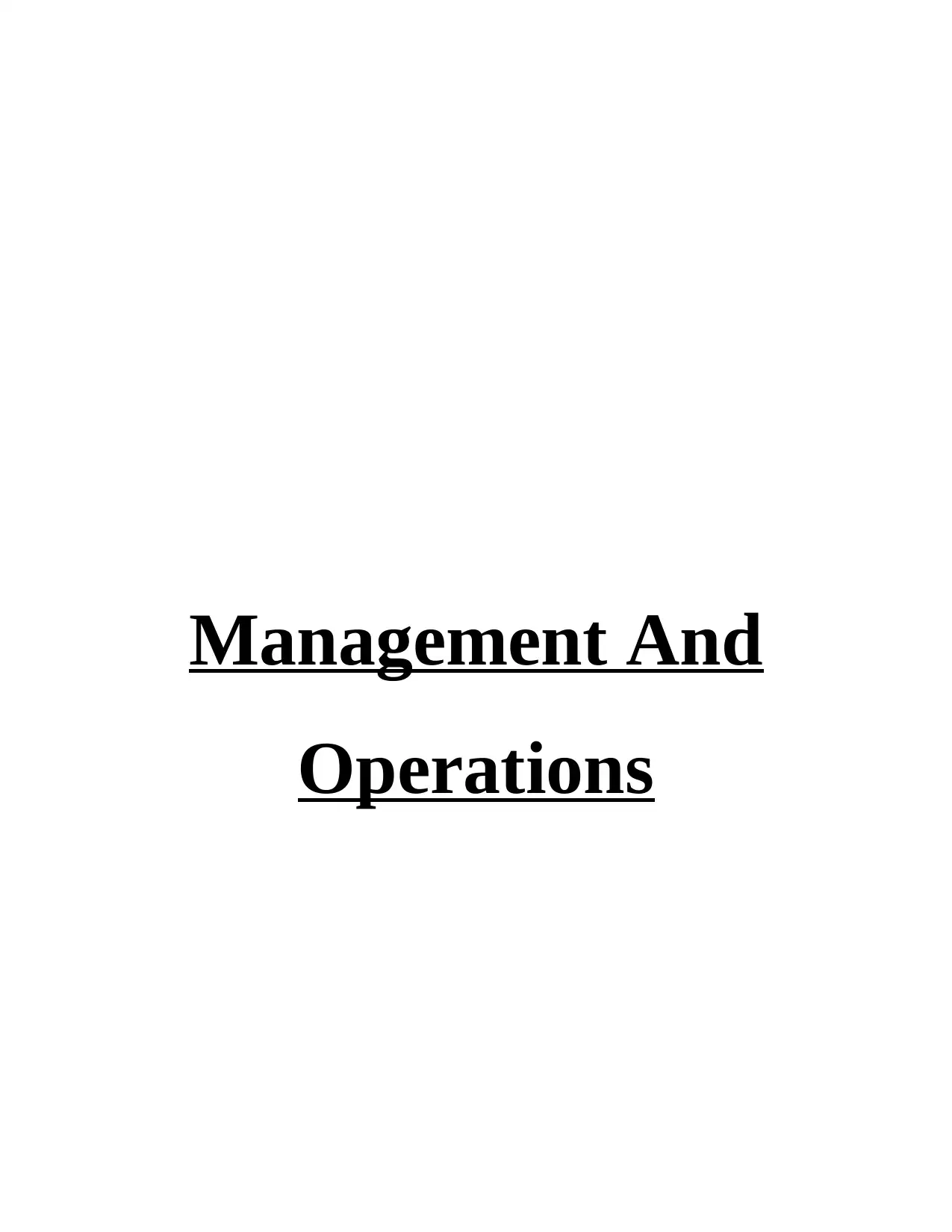
Management And
Operations
Operations
Paraphrase This Document
Need a fresh take? Get an instant paraphrase of this document with our AI Paraphraser
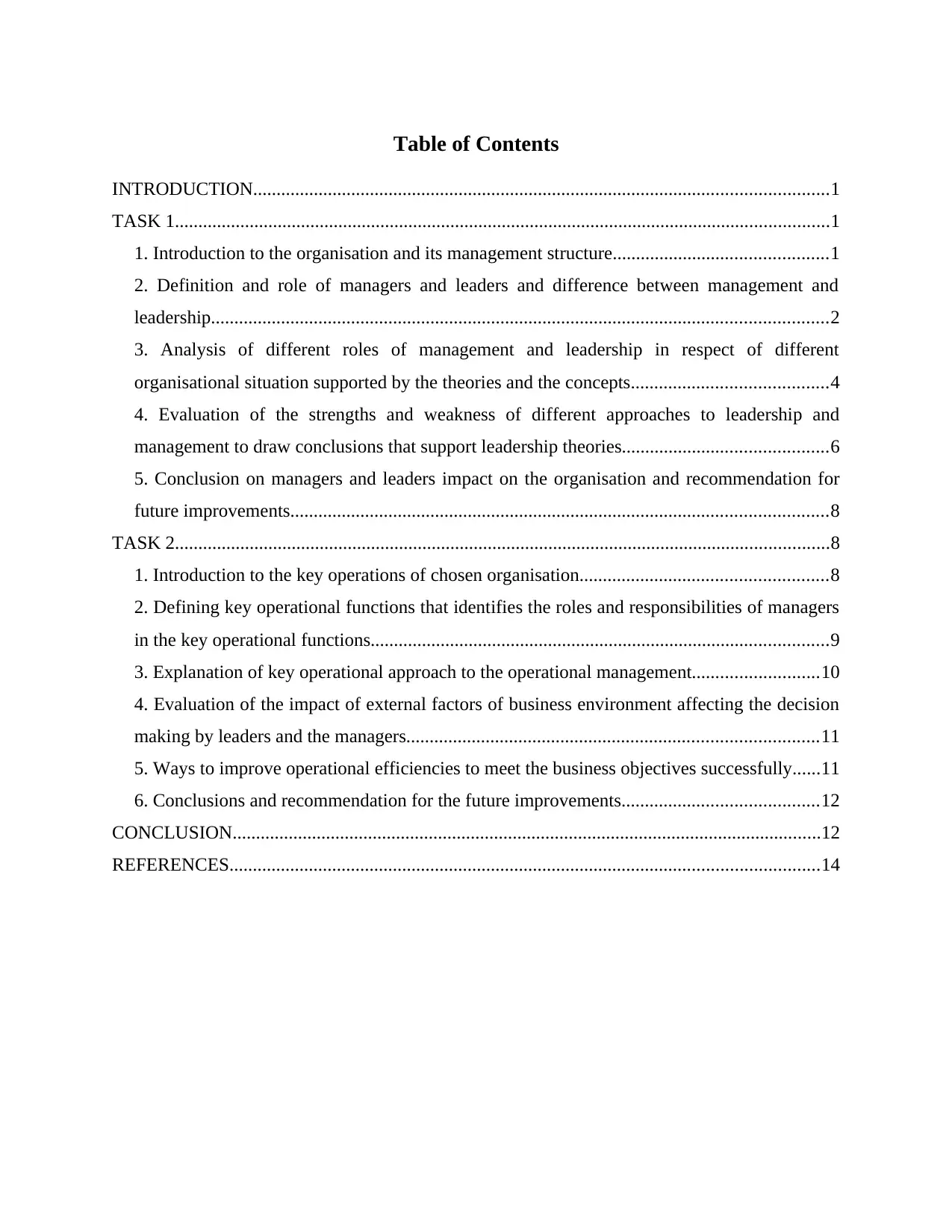
Table of Contents
INTRODUCTION...........................................................................................................................1
TASK 1............................................................................................................................................1
1. Introduction to the organisation and its management structure..............................................1
2. Definition and role of managers and leaders and difference between management and
leadership....................................................................................................................................2
3. Analysis of different roles of management and leadership in respect of different
organisational situation supported by the theories and the concepts..........................................4
4. Evaluation of the strengths and weakness of different approaches to leadership and
management to draw conclusions that support leadership theories............................................6
5. Conclusion on managers and leaders impact on the organisation and recommendation for
future improvements...................................................................................................................8
TASK 2............................................................................................................................................8
1. Introduction to the key operations of chosen organisation.....................................................8
2. Defining key operational functions that identifies the roles and responsibilities of managers
in the key operational functions..................................................................................................9
3. Explanation of key operational approach to the operational management...........................10
4. Evaluation of the impact of external factors of business environment affecting the decision
making by leaders and the managers........................................................................................11
5. Ways to improve operational efficiencies to meet the business objectives successfully......11
6. Conclusions and recommendation for the future improvements..........................................12
CONCLUSION..............................................................................................................................12
REFERENCES..............................................................................................................................14
INTRODUCTION...........................................................................................................................1
TASK 1............................................................................................................................................1
1. Introduction to the organisation and its management structure..............................................1
2. Definition and role of managers and leaders and difference between management and
leadership....................................................................................................................................2
3. Analysis of different roles of management and leadership in respect of different
organisational situation supported by the theories and the concepts..........................................4
4. Evaluation of the strengths and weakness of different approaches to leadership and
management to draw conclusions that support leadership theories............................................6
5. Conclusion on managers and leaders impact on the organisation and recommendation for
future improvements...................................................................................................................8
TASK 2............................................................................................................................................8
1. Introduction to the key operations of chosen organisation.....................................................8
2. Defining key operational functions that identifies the roles and responsibilities of managers
in the key operational functions..................................................................................................9
3. Explanation of key operational approach to the operational management...........................10
4. Evaluation of the impact of external factors of business environment affecting the decision
making by leaders and the managers........................................................................................11
5. Ways to improve operational efficiencies to meet the business objectives successfully......11
6. Conclusions and recommendation for the future improvements..........................................12
CONCLUSION..............................................................................................................................12
REFERENCES..............................................................................................................................14
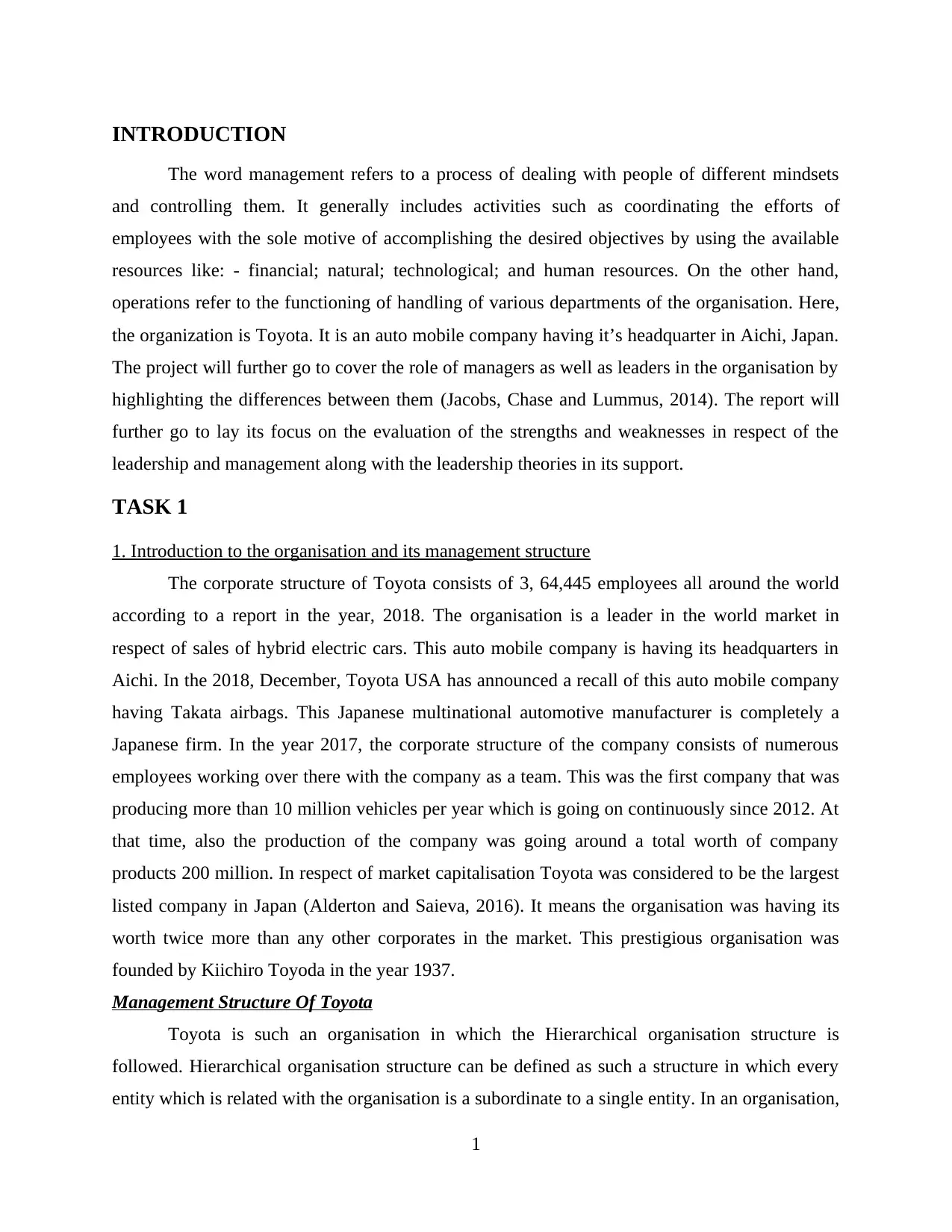
INTRODUCTION
The word management refers to a process of dealing with people of different mindsets
and controlling them. It generally includes activities such as coordinating the efforts of
employees with the sole motive of accomplishing the desired objectives by using the available
resources like: - financial; natural; technological; and human resources. On the other hand,
operations refer to the functioning of handling of various departments of the organisation. Here,
the organization is Toyota. It is an auto mobile company having it’s headquarter in Aichi, Japan.
The project will further go to cover the role of managers as well as leaders in the organisation by
highlighting the differences between them (Jacobs, Chase and Lummus, 2014). The report will
further go to lay its focus on the evaluation of the strengths and weaknesses in respect of the
leadership and management along with the leadership theories in its support.
TASK 1
1. Introduction to the organisation and its management structure
The corporate structure of Toyota consists of 3, 64,445 employees all around the world
according to a report in the year, 2018. The organisation is a leader in the world market in
respect of sales of hybrid electric cars. This auto mobile company is having its headquarters in
Aichi. In the 2018, December, Toyota USA has announced a recall of this auto mobile company
having Takata airbags. This Japanese multinational automotive manufacturer is completely a
Japanese firm. In the year 2017, the corporate structure of the company consists of numerous
employees working over there with the company as a team. This was the first company that was
producing more than 10 million vehicles per year which is going on continuously since 2012. At
that time, also the production of the company was going around a total worth of company
products 200 million. In respect of market capitalisation Toyota was considered to be the largest
listed company in Japan (Alderton and Saieva, 2016). It means the organisation was having its
worth twice more than any other corporates in the market. This prestigious organisation was
founded by Kiichiro Toyoda in the year 1937.
Management Structure Of Toyota
Toyota is such an organisation in which the Hierarchical organisation structure is
followed. Hierarchical organisation structure can be defined as such a structure in which every
entity which is related with the organisation is a subordinate to a single entity. In an organisation,
1
The word management refers to a process of dealing with people of different mindsets
and controlling them. It generally includes activities such as coordinating the efforts of
employees with the sole motive of accomplishing the desired objectives by using the available
resources like: - financial; natural; technological; and human resources. On the other hand,
operations refer to the functioning of handling of various departments of the organisation. Here,
the organization is Toyota. It is an auto mobile company having it’s headquarter in Aichi, Japan.
The project will further go to cover the role of managers as well as leaders in the organisation by
highlighting the differences between them (Jacobs, Chase and Lummus, 2014). The report will
further go to lay its focus on the evaluation of the strengths and weaknesses in respect of the
leadership and management along with the leadership theories in its support.
TASK 1
1. Introduction to the organisation and its management structure
The corporate structure of Toyota consists of 3, 64,445 employees all around the world
according to a report in the year, 2018. The organisation is a leader in the world market in
respect of sales of hybrid electric cars. This auto mobile company is having its headquarters in
Aichi. In the 2018, December, Toyota USA has announced a recall of this auto mobile company
having Takata airbags. This Japanese multinational automotive manufacturer is completely a
Japanese firm. In the year 2017, the corporate structure of the company consists of numerous
employees working over there with the company as a team. This was the first company that was
producing more than 10 million vehicles per year which is going on continuously since 2012. At
that time, also the production of the company was going around a total worth of company
products 200 million. In respect of market capitalisation Toyota was considered to be the largest
listed company in Japan (Alderton and Saieva, 2016). It means the organisation was having its
worth twice more than any other corporates in the market. This prestigious organisation was
founded by Kiichiro Toyoda in the year 1937.
Management Structure Of Toyota
Toyota is such an organisation in which the Hierarchical organisation structure is
followed. Hierarchical organisation structure can be defined as such a structure in which every
entity which is related with the organisation is a subordinate to a single entity. In an organisation,
1
⊘ This is a preview!⊘
Do you want full access?
Subscribe today to unlock all pages.

Trusted by 1+ million students worldwide

like Toyota, the hierarchy usually consists of a singular group. In this case, the power lies at the
top with the subsequent levels of power beneath them. It is also considered to be the dominating
mode of the organization(O'Fallon and Rutherford, 2019). In Toyota the production manager is
responsible for getting the production of targeted lot of vehicles to be done in a given time
period.
2. Definition and role of managers and leaders and difference between management and
leadership
Manager:- It can be defined as an individual who is responsible for handling and taking
charge of group of tasks or of any sister concern or subset of the company. The manager of
Toyota is accountable for performing all the functions and duties for which he is liable and also
to take care of members that are working under his team.
Leader:- A leader can be defined as someone who is taking charge of leading an entire
group of persons that are working under his guidance in an organisation. In Toyota, a leader
basically plays the role of taking all the team members together by keeping managed the tasks of
all team members (Slack, 2016).
2
(Source: Structure of Toyota, 2016)
top with the subsequent levels of power beneath them. It is also considered to be the dominating
mode of the organization(O'Fallon and Rutherford, 2019). In Toyota the production manager is
responsible for getting the production of targeted lot of vehicles to be done in a given time
period.
2. Definition and role of managers and leaders and difference between management and
leadership
Manager:- It can be defined as an individual who is responsible for handling and taking
charge of group of tasks or of any sister concern or subset of the company. The manager of
Toyota is accountable for performing all the functions and duties for which he is liable and also
to take care of members that are working under his team.
Leader:- A leader can be defined as someone who is taking charge of leading an entire
group of persons that are working under his guidance in an organisation. In Toyota, a leader
basically plays the role of taking all the team members together by keeping managed the tasks of
all team members (Slack, 2016).
2
(Source: Structure of Toyota, 2016)
Paraphrase This Document
Need a fresh take? Get an instant paraphrase of this document with our AI Paraphraser
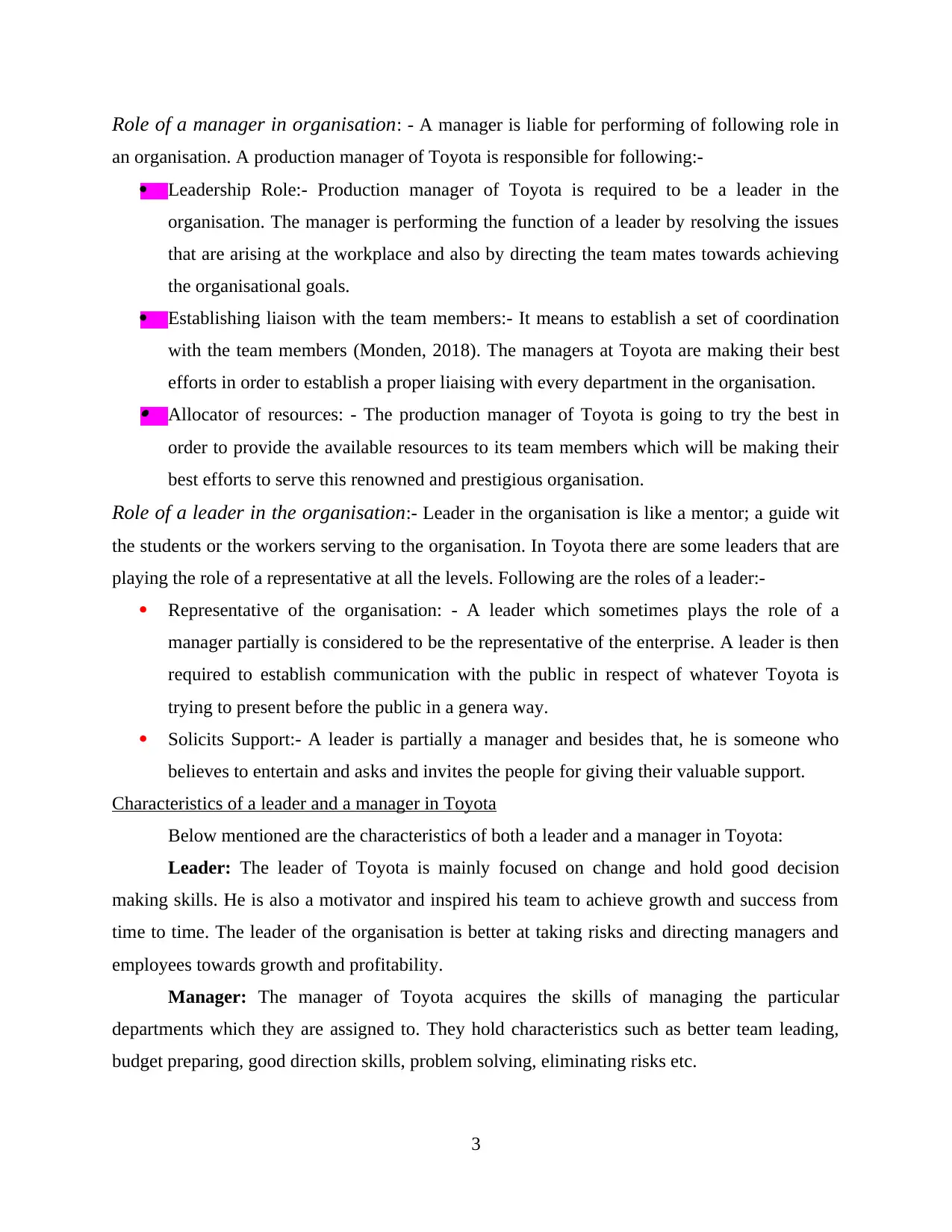
Role of a manager in organisation: - A manager is liable for performing of following role in
an organisation. A production manager of Toyota is responsible for following:-
Leadership Role:- Production manager of Toyota is required to be a leader in the
organisation. The manager is performing the function of a leader by resolving the issues
that are arising at the workplace and also by directing the team mates towards achieving
the organisational goals.
Establishing liaison with the team members:- It means to establish a set of coordination
with the team members (Monden, 2018). The managers at Toyota are making their best
efforts in order to establish a proper liaising with every department in the organisation. Allocator of resources: - The production manager of Toyota is going to try the best in
order to provide the available resources to its team members which will be making their
best efforts to serve this renowned and prestigious organisation.
Role of a leader in the organisation:- Leader in the organisation is like a mentor; a guide wit
the students or the workers serving to the organisation. In Toyota there are some leaders that are
playing the role of a representative at all the levels. Following are the roles of a leader:-
Representative of the organisation: - A leader which sometimes plays the role of a
manager partially is considered to be the representative of the enterprise. A leader is then
required to establish communication with the public in respect of whatever Toyota is
trying to present before the public in a genera way.
Solicits Support:- A leader is partially a manager and besides that, he is someone who
believes to entertain and asks and invites the people for giving their valuable support.
Characteristics of a leader and a manager in Toyota
Below mentioned are the characteristics of both a leader and a manager in Toyota:
Leader: The leader of Toyota is mainly focused on change and hold good decision
making skills. He is also a motivator and inspired his team to achieve growth and success from
time to time. The leader of the organisation is better at taking risks and directing managers and
employees towards growth and profitability.
Manager: The manager of Toyota acquires the skills of managing the particular
departments which they are assigned to. They hold characteristics such as better team leading,
budget preparing, good direction skills, problem solving, eliminating risks etc.
3
an organisation. A production manager of Toyota is responsible for following:-
Leadership Role:- Production manager of Toyota is required to be a leader in the
organisation. The manager is performing the function of a leader by resolving the issues
that are arising at the workplace and also by directing the team mates towards achieving
the organisational goals.
Establishing liaison with the team members:- It means to establish a set of coordination
with the team members (Monden, 2018). The managers at Toyota are making their best
efforts in order to establish a proper liaising with every department in the organisation. Allocator of resources: - The production manager of Toyota is going to try the best in
order to provide the available resources to its team members which will be making their
best efforts to serve this renowned and prestigious organisation.
Role of a leader in the organisation:- Leader in the organisation is like a mentor; a guide wit
the students or the workers serving to the organisation. In Toyota there are some leaders that are
playing the role of a representative at all the levels. Following are the roles of a leader:-
Representative of the organisation: - A leader which sometimes plays the role of a
manager partially is considered to be the representative of the enterprise. A leader is then
required to establish communication with the public in respect of whatever Toyota is
trying to present before the public in a genera way.
Solicits Support:- A leader is partially a manager and besides that, he is someone who
believes to entertain and asks and invites the people for giving their valuable support.
Characteristics of a leader and a manager in Toyota
Below mentioned are the characteristics of both a leader and a manager in Toyota:
Leader: The leader of Toyota is mainly focused on change and hold good decision
making skills. He is also a motivator and inspired his team to achieve growth and success from
time to time. The leader of the organisation is better at taking risks and directing managers and
employees towards growth and profitability.
Manager: The manager of Toyota acquires the skills of managing the particular
departments which they are assigned to. They hold characteristics such as better team leading,
budget preparing, good direction skills, problem solving, eliminating risks etc.
3
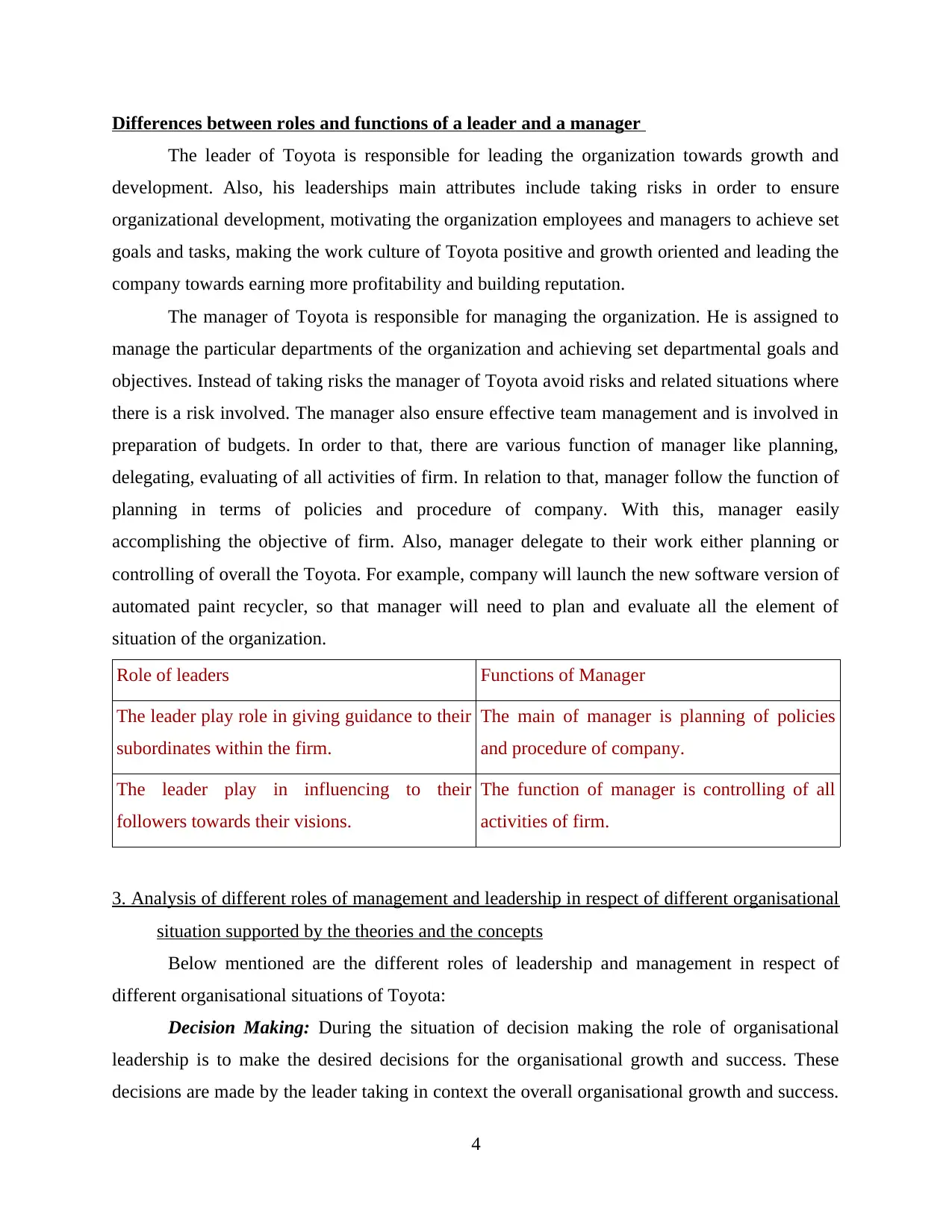
Differences between roles and functions of a leader and a manager
The leader of Toyota is responsible for leading the organization towards growth and
development. Also, his leaderships main attributes include taking risks in order to ensure
organizational development, motivating the organization employees and managers to achieve set
goals and tasks, making the work culture of Toyota positive and growth oriented and leading the
company towards earning more profitability and building reputation.
The manager of Toyota is responsible for managing the organization. He is assigned to
manage the particular departments of the organization and achieving set departmental goals and
objectives. Instead of taking risks the manager of Toyota avoid risks and related situations where
there is a risk involved. The manager also ensure effective team management and is involved in
preparation of budgets. In order to that, there are various function of manager like planning,
delegating, evaluating of all activities of firm. In relation to that, manager follow the function of
planning in terms of policies and procedure of company. With this, manager easily
accomplishing the objective of firm. Also, manager delegate to their work either planning or
controlling of overall the Toyota. For example, company will launch the new software version of
automated paint recycler, so that manager will need to plan and evaluate all the element of
situation of the organization.
Role of leaders Functions of Manager
The leader play role in giving guidance to their
subordinates within the firm.
The main of manager is planning of policies
and procedure of company.
The leader play in influencing to their
followers towards their visions.
The function of manager is controlling of all
activities of firm.
3. Analysis of different roles of management and leadership in respect of different organisational
situation supported by the theories and the concepts
Below mentioned are the different roles of leadership and management in respect of
different organisational situations of Toyota:
Decision Making: During the situation of decision making the role of organisational
leadership is to make the desired decisions for the organisational growth and success. These
decisions are made by the leader taking in context the overall organisational growth and success.
4
The leader of Toyota is responsible for leading the organization towards growth and
development. Also, his leaderships main attributes include taking risks in order to ensure
organizational development, motivating the organization employees and managers to achieve set
goals and tasks, making the work culture of Toyota positive and growth oriented and leading the
company towards earning more profitability and building reputation.
The manager of Toyota is responsible for managing the organization. He is assigned to
manage the particular departments of the organization and achieving set departmental goals and
objectives. Instead of taking risks the manager of Toyota avoid risks and related situations where
there is a risk involved. The manager also ensure effective team management and is involved in
preparation of budgets. In order to that, there are various function of manager like planning,
delegating, evaluating of all activities of firm. In relation to that, manager follow the function of
planning in terms of policies and procedure of company. With this, manager easily
accomplishing the objective of firm. Also, manager delegate to their work either planning or
controlling of overall the Toyota. For example, company will launch the new software version of
automated paint recycler, so that manager will need to plan and evaluate all the element of
situation of the organization.
Role of leaders Functions of Manager
The leader play role in giving guidance to their
subordinates within the firm.
The main of manager is planning of policies
and procedure of company.
The leader play in influencing to their
followers towards their visions.
The function of manager is controlling of all
activities of firm.
3. Analysis of different roles of management and leadership in respect of different organisational
situation supported by the theories and the concepts
Below mentioned are the different roles of leadership and management in respect of
different organisational situations of Toyota:
Decision Making: During the situation of decision making the role of organisational
leadership is to make the desired decisions for the organisational growth and success. These
decisions are made by the leader taking in context the overall organisational growth and success.
4
⊘ This is a preview!⊘
Do you want full access?
Subscribe today to unlock all pages.

Trusted by 1+ million students worldwide
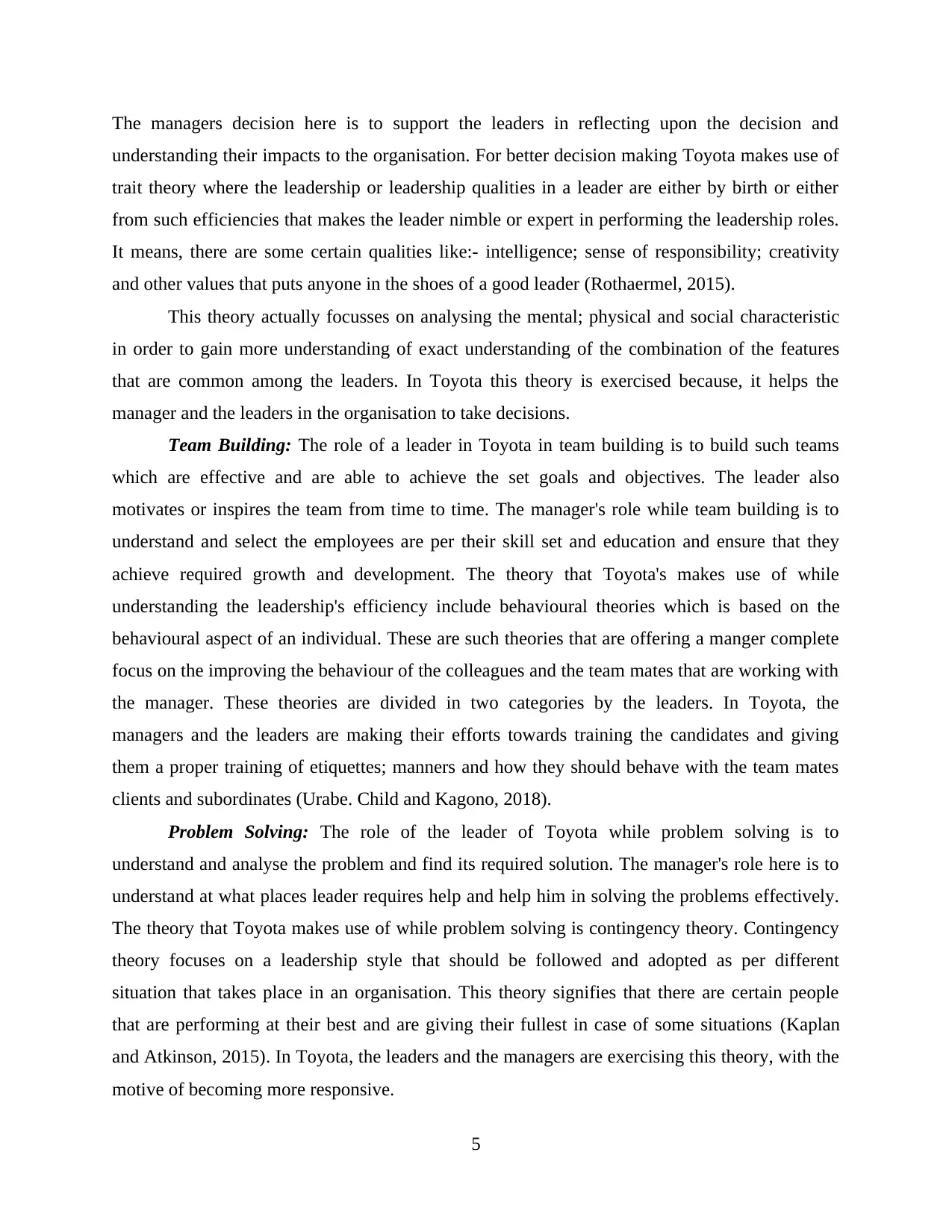
The managers decision here is to support the leaders in reflecting upon the decision and
understanding their impacts to the organisation. For better decision making Toyota makes use of
trait theory where the leadership or leadership qualities in a leader are either by birth or either
from such efficiencies that makes the leader nimble or expert in performing the leadership roles.
It means, there are some certain qualities like:- intelligence; sense of responsibility; creativity
and other values that puts anyone in the shoes of a good leader (Rothaermel, 2015).
This theory actually focusses on analysing the mental; physical and social characteristic
in order to gain more understanding of exact understanding of the combination of the features
that are common among the leaders. In Toyota this theory is exercised because, it helps the
manager and the leaders in the organisation to take decisions.
Team Building: The role of a leader in Toyota in team building is to build such teams
which are effective and are able to achieve the set goals and objectives. The leader also
motivates or inspires the team from time to time. The manager's role while team building is to
understand and select the employees are per their skill set and education and ensure that they
achieve required growth and development. The theory that Toyota's makes use of while
understanding the leadership's efficiency include behavioural theories which is based on the
behavioural aspect of an individual. These are such theories that are offering a manger complete
focus on the improving the behaviour of the colleagues and the team mates that are working with
the manager. These theories are divided in two categories by the leaders. In Toyota, the
managers and the leaders are making their efforts towards training the candidates and giving
them a proper training of etiquettes; manners and how they should behave with the team mates
clients and subordinates (Urabe. Child and Kagono, 2018).
Problem Solving: The role of the leader of Toyota while problem solving is to
understand and analyse the problem and find its required solution. The manager's role here is to
understand at what places leader requires help and help him in solving the problems effectively.
The theory that Toyota makes use of while problem solving is contingency theory. Contingency
theory focuses on a leadership style that should be followed and adopted as per different
situation that takes place in an organisation. This theory signifies that there are certain people
that are performing at their best and are giving their fullest in case of some situations (Kaplan
and Atkinson, 2015). In Toyota, the leaders and the managers are exercising this theory, with the
motive of becoming more responsive.
5
understanding their impacts to the organisation. For better decision making Toyota makes use of
trait theory where the leadership or leadership qualities in a leader are either by birth or either
from such efficiencies that makes the leader nimble or expert in performing the leadership roles.
It means, there are some certain qualities like:- intelligence; sense of responsibility; creativity
and other values that puts anyone in the shoes of a good leader (Rothaermel, 2015).
This theory actually focusses on analysing the mental; physical and social characteristic
in order to gain more understanding of exact understanding of the combination of the features
that are common among the leaders. In Toyota this theory is exercised because, it helps the
manager and the leaders in the organisation to take decisions.
Team Building: The role of a leader in Toyota in team building is to build such teams
which are effective and are able to achieve the set goals and objectives. The leader also
motivates or inspires the team from time to time. The manager's role while team building is to
understand and select the employees are per their skill set and education and ensure that they
achieve required growth and development. The theory that Toyota's makes use of while
understanding the leadership's efficiency include behavioural theories which is based on the
behavioural aspect of an individual. These are such theories that are offering a manger complete
focus on the improving the behaviour of the colleagues and the team mates that are working with
the manager. These theories are divided in two categories by the leaders. In Toyota, the
managers and the leaders are making their efforts towards training the candidates and giving
them a proper training of etiquettes; manners and how they should behave with the team mates
clients and subordinates (Urabe. Child and Kagono, 2018).
Problem Solving: The role of the leader of Toyota while problem solving is to
understand and analyse the problem and find its required solution. The manager's role here is to
understand at what places leader requires help and help him in solving the problems effectively.
The theory that Toyota makes use of while problem solving is contingency theory. Contingency
theory focuses on a leadership style that should be followed and adopted as per different
situation that takes place in an organisation. This theory signifies that there are certain people
that are performing at their best and are giving their fullest in case of some situations (Kaplan
and Atkinson, 2015). In Toyota, the leaders and the managers are exercising this theory, with the
motive of becoming more responsive.
5
Paraphrase This Document
Need a fresh take? Get an instant paraphrase of this document with our AI Paraphraser
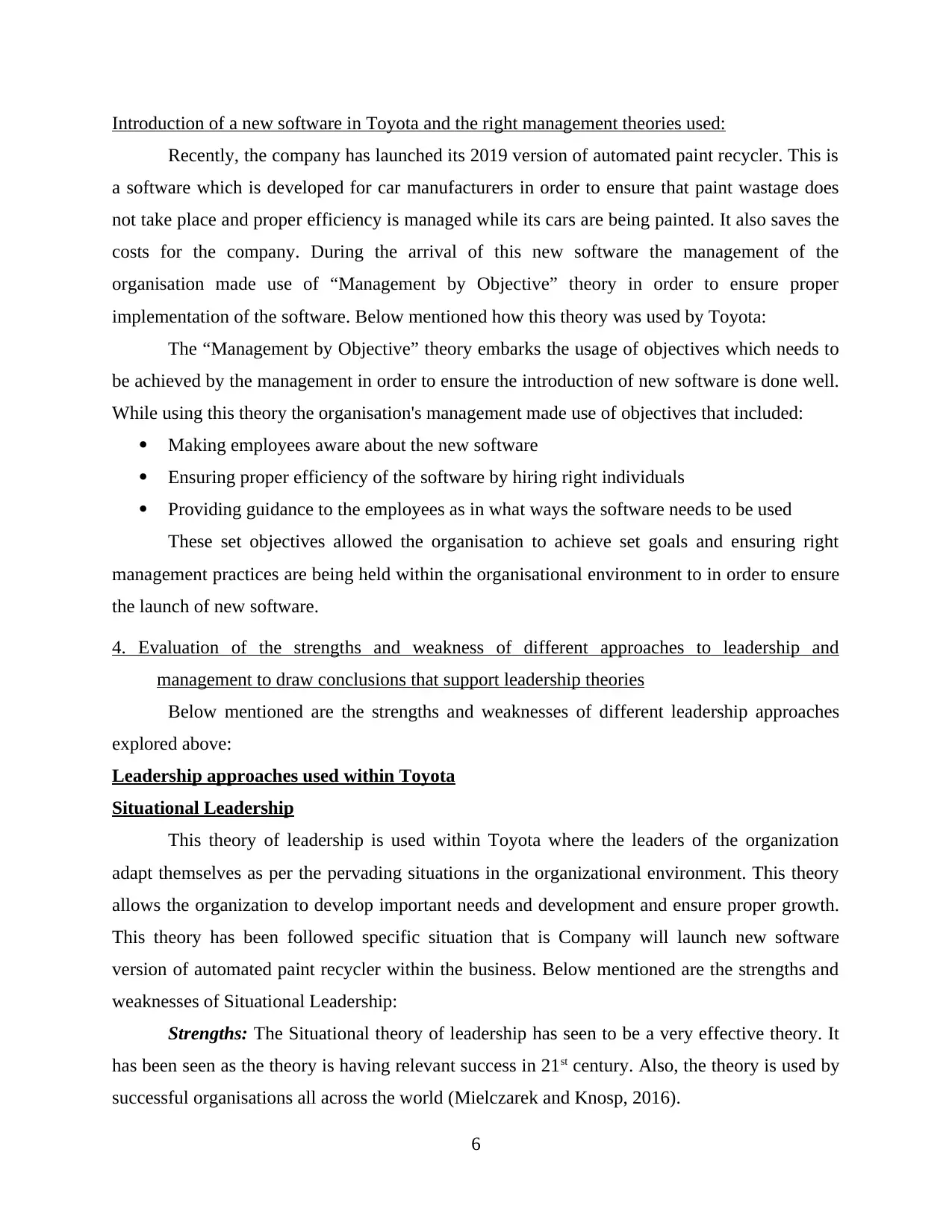
Introduction of a new software in Toyota and the right management theories used:
Recently, the company has launched its 2019 version of automated paint recycler. This is
a software which is developed for car manufacturers in order to ensure that paint wastage does
not take place and proper efficiency is managed while its cars are being painted. It also saves the
costs for the company. During the arrival of this new software the management of the
organisation made use of “Management by Objective” theory in order to ensure proper
implementation of the software. Below mentioned how this theory was used by Toyota:
The “Management by Objective” theory embarks the usage of objectives which needs to
be achieved by the management in order to ensure the introduction of new software is done well.
While using this theory the organisation's management made use of objectives that included:
Making employees aware about the new software
Ensuring proper efficiency of the software by hiring right individuals
Providing guidance to the employees as in what ways the software needs to be used
These set objectives allowed the organisation to achieve set goals and ensuring right
management practices are being held within the organisational environment to in order to ensure
the launch of new software.
4. Evaluation of the strengths and weakness of different approaches to leadership and
management to draw conclusions that support leadership theories
Below mentioned are the strengths and weaknesses of different leadership approaches
explored above:
Leadership approaches used within Toyota
Situational Leadership
This theory of leadership is used within Toyota where the leaders of the organization
adapt themselves as per the pervading situations in the organizational environment. This theory
allows the organization to develop important needs and development and ensure proper growth.
This theory has been followed specific situation that is Company will launch new software
version of automated paint recycler within the business. Below mentioned are the strengths and
weaknesses of Situational Leadership:
Strengths: The Situational theory of leadership has seen to be a very effective theory. It
has been seen as the theory is having relevant success in 21st century. Also, the theory is used by
successful organisations all across the world (Mielczarek and Knosp, 2016).
6
Recently, the company has launched its 2019 version of automated paint recycler. This is
a software which is developed for car manufacturers in order to ensure that paint wastage does
not take place and proper efficiency is managed while its cars are being painted. It also saves the
costs for the company. During the arrival of this new software the management of the
organisation made use of “Management by Objective” theory in order to ensure proper
implementation of the software. Below mentioned how this theory was used by Toyota:
The “Management by Objective” theory embarks the usage of objectives which needs to
be achieved by the management in order to ensure the introduction of new software is done well.
While using this theory the organisation's management made use of objectives that included:
Making employees aware about the new software
Ensuring proper efficiency of the software by hiring right individuals
Providing guidance to the employees as in what ways the software needs to be used
These set objectives allowed the organisation to achieve set goals and ensuring right
management practices are being held within the organisational environment to in order to ensure
the launch of new software.
4. Evaluation of the strengths and weakness of different approaches to leadership and
management to draw conclusions that support leadership theories
Below mentioned are the strengths and weaknesses of different leadership approaches
explored above:
Leadership approaches used within Toyota
Situational Leadership
This theory of leadership is used within Toyota where the leaders of the organization
adapt themselves as per the pervading situations in the organizational environment. This theory
allows the organization to develop important needs and development and ensure proper growth.
This theory has been followed specific situation that is Company will launch new software
version of automated paint recycler within the business. Below mentioned are the strengths and
weaknesses of Situational Leadership:
Strengths: The Situational theory of leadership has seen to be a very effective theory. It
has been seen as the theory is having relevant success in 21st century. Also, the theory is used by
successful organisations all across the world (Mielczarek and Knosp, 2016).
6
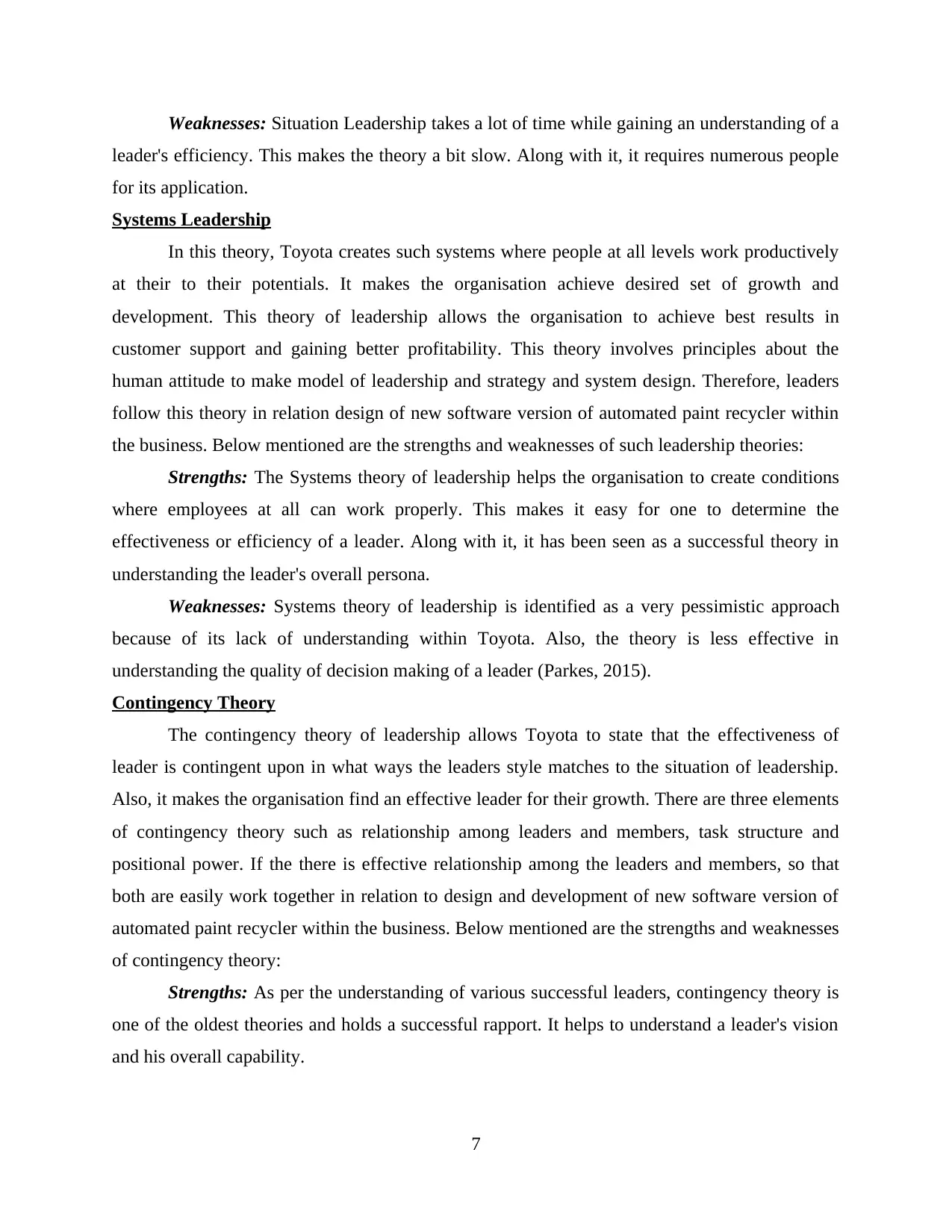
Weaknesses: Situation Leadership takes a lot of time while gaining an understanding of a
leader's efficiency. This makes the theory a bit slow. Along with it, it requires numerous people
for its application.
Systems Leadership
In this theory, Toyota creates such systems where people at all levels work productively
at their to their potentials. It makes the organisation achieve desired set of growth and
development. This theory of leadership allows the organisation to achieve best results in
customer support and gaining better profitability. This theory involves principles about the
human attitude to make model of leadership and strategy and system design. Therefore, leaders
follow this theory in relation design of new software version of automated paint recycler within
the business. Below mentioned are the strengths and weaknesses of such leadership theories:
Strengths: The Systems theory of leadership helps the organisation to create conditions
where employees at all can work properly. This makes it easy for one to determine the
effectiveness or efficiency of a leader. Along with it, it has been seen as a successful theory in
understanding the leader's overall persona.
Weaknesses: Systems theory of leadership is identified as a very pessimistic approach
because of its lack of understanding within Toyota. Also, the theory is less effective in
understanding the quality of decision making of a leader (Parkes, 2015).
Contingency Theory
The contingency theory of leadership allows Toyota to state that the effectiveness of
leader is contingent upon in what ways the leaders style matches to the situation of leadership.
Also, it makes the organisation find an effective leader for their growth. There are three elements
of contingency theory such as relationship among leaders and members, task structure and
positional power. If the there is effective relationship among the leaders and members, so that
both are easily work together in relation to design and development of new software version of
automated paint recycler within the business. Below mentioned are the strengths and weaknesses
of contingency theory:
Strengths: As per the understanding of various successful leaders, contingency theory is
one of the oldest theories and holds a successful rapport. It helps to understand a leader's vision
and his overall capability.
7
leader's efficiency. This makes the theory a bit slow. Along with it, it requires numerous people
for its application.
Systems Leadership
In this theory, Toyota creates such systems where people at all levels work productively
at their to their potentials. It makes the organisation achieve desired set of growth and
development. This theory of leadership allows the organisation to achieve best results in
customer support and gaining better profitability. This theory involves principles about the
human attitude to make model of leadership and strategy and system design. Therefore, leaders
follow this theory in relation design of new software version of automated paint recycler within
the business. Below mentioned are the strengths and weaknesses of such leadership theories:
Strengths: The Systems theory of leadership helps the organisation to create conditions
where employees at all can work properly. This makes it easy for one to determine the
effectiveness or efficiency of a leader. Along with it, it has been seen as a successful theory in
understanding the leader's overall persona.
Weaknesses: Systems theory of leadership is identified as a very pessimistic approach
because of its lack of understanding within Toyota. Also, the theory is less effective in
understanding the quality of decision making of a leader (Parkes, 2015).
Contingency Theory
The contingency theory of leadership allows Toyota to state that the effectiveness of
leader is contingent upon in what ways the leaders style matches to the situation of leadership.
Also, it makes the organisation find an effective leader for their growth. There are three elements
of contingency theory such as relationship among leaders and members, task structure and
positional power. If the there is effective relationship among the leaders and members, so that
both are easily work together in relation to design and development of new software version of
automated paint recycler within the business. Below mentioned are the strengths and weaknesses
of contingency theory:
Strengths: As per the understanding of various successful leaders, contingency theory is
one of the oldest theories and holds a successful rapport. It helps to understand a leader's vision
and his overall capability.
7
⊘ This is a preview!⊘
Do you want full access?
Subscribe today to unlock all pages.

Trusted by 1+ million students worldwide

Weaknesses: The contingency theory of leadership is very inefficient in modern times as
it works on the process and understanding of late 90's leadership styles. Along with it, the theory
has failed in modern situations and has lacked improvised vision of a leader (Jacobs, Chase and
Lummus, 2014).
Above mentioned are various leadership theories and their strengths and weaknesses.
Leaders and managers make efforts to improve the operational efficiencies by following
the different theories and styles like system, situational and contingency, democratic and
transactional styles within the Toyota. In this context, managers can be followed the democratic
style in which they pushed their employees in terms of involvement in launch the new software
version of automated paint recycler. Leaders can be followed the situational leadership theory for
solving the any situation while launch the new software version of automated paint recycler by
the Toyota.
5. Conclusion on managers and leaders impact on the organisation and recommendation for
future improvements
From the above analysis, it has been concluded that leadership of Toyota is effective and
holds a good value within the organisational environment (Slack, 2016). It has been seen that the
overall management of Toyota lacks growth in understanding the worldwide scenario to produce
and sell their products and services. In order to improve this, it is important for the organisation
to make use of effective strategies such as focusing on product management, being more
opportunistic, learn to adapt into growing economies etc. These efforts can make the overall
organisation improve further and lead it towards growth and achievements.
TASK 2
1. Introduction to the key operations of chosen organisation
The key operations of an organisation are concerned with controlling, planning, directing
and organising of all the activities taking place within its business environment. These operations
manage the activities from conversion of raw materials and human efforts into valuable services
and goods to satisfy the overall customer needs.
Below explained are the key operations of Toyota:1. Production and Designing: Production and designing is one of the most important key
operations of Toyota. This is where its cars are designed and are built and where overall
8
it works on the process and understanding of late 90's leadership styles. Along with it, the theory
has failed in modern situations and has lacked improvised vision of a leader (Jacobs, Chase and
Lummus, 2014).
Above mentioned are various leadership theories and their strengths and weaknesses.
Leaders and managers make efforts to improve the operational efficiencies by following
the different theories and styles like system, situational and contingency, democratic and
transactional styles within the Toyota. In this context, managers can be followed the democratic
style in which they pushed their employees in terms of involvement in launch the new software
version of automated paint recycler. Leaders can be followed the situational leadership theory for
solving the any situation while launch the new software version of automated paint recycler by
the Toyota.
5. Conclusion on managers and leaders impact on the organisation and recommendation for
future improvements
From the above analysis, it has been concluded that leadership of Toyota is effective and
holds a good value within the organisational environment (Slack, 2016). It has been seen that the
overall management of Toyota lacks growth in understanding the worldwide scenario to produce
and sell their products and services. In order to improve this, it is important for the organisation
to make use of effective strategies such as focusing on product management, being more
opportunistic, learn to adapt into growing economies etc. These efforts can make the overall
organisation improve further and lead it towards growth and achievements.
TASK 2
1. Introduction to the key operations of chosen organisation
The key operations of an organisation are concerned with controlling, planning, directing
and organising of all the activities taking place within its business environment. These operations
manage the activities from conversion of raw materials and human efforts into valuable services
and goods to satisfy the overall customer needs.
Below explained are the key operations of Toyota:1. Production and Designing: Production and designing is one of the most important key
operations of Toyota. This is where its cars are designed and are built and where overall
8
Paraphrase This Document
Need a fresh take? Get an instant paraphrase of this document with our AI Paraphraser

production takes place. The overseeing of the production is done by the top management
and production team of the organisation.2. Supply Chain Management: The supply chain management deals with the Selling and
distribution of the cars which Toyota has made and the practices followed in order to sell
them as required. Along with it, the organisation's distribution makes sure proper
distribution in supply chain management process.3. Quality Management: The Quality management of the organisation deals with providing
effective quality to the products made in the organisation and creating better
improvements. It also controls the overall quality of production, selling and maintenance
as well.
4. Maintenance: The maintenance operations of Toyota deal with maintaining products and
services and overall organisations operations. This ensures better delivery of products and
services and overall growth and improvement of the organisation.
Above mentioned are the key operations of Toyota.
2. Defining key operational functions that identifies the roles and responsibilities of managers in
the key operational functions
P4 Below mentioned are the key operations of Toyota's and the roles and responsibilities of
leader and managers in them:
1. Production: The production department in Toyota ensures quality production of
the vehicles as per the organisations standards and built quality. The production
makes sure that the organisation is producing it products and services as required
needs and demands. The role and responsibilities of an organisational manager
here is to ensure smooth operations by successfully understanding the market
needs. Along with it, they ensure supply of the products as per the needs and
demands of the consumer market (Toyota's vision and action, 2018).
2. Selling and distribution: Selling and distribution ensures that the products of
Toyota are sold and distributed in the market as per the needs of the customers
and the organisations as well. Proper selling and distribution is one of the core
aspects that management has to keep an eye on. The managers of Toyota ensure
that effective selling and distribution is going on. Along with it, they ensure that
are no inefficiencies in the organisation and its environment.
9
and production team of the organisation.2. Supply Chain Management: The supply chain management deals with the Selling and
distribution of the cars which Toyota has made and the practices followed in order to sell
them as required. Along with it, the organisation's distribution makes sure proper
distribution in supply chain management process.3. Quality Management: The Quality management of the organisation deals with providing
effective quality to the products made in the organisation and creating better
improvements. It also controls the overall quality of production, selling and maintenance
as well.
4. Maintenance: The maintenance operations of Toyota deal with maintaining products and
services and overall organisations operations. This ensures better delivery of products and
services and overall growth and improvement of the organisation.
Above mentioned are the key operations of Toyota.
2. Defining key operational functions that identifies the roles and responsibilities of managers in
the key operational functions
P4 Below mentioned are the key operations of Toyota's and the roles and responsibilities of
leader and managers in them:
1. Production: The production department in Toyota ensures quality production of
the vehicles as per the organisations standards and built quality. The production
makes sure that the organisation is producing it products and services as required
needs and demands. The role and responsibilities of an organisational manager
here is to ensure smooth operations by successfully understanding the market
needs. Along with it, they ensure supply of the products as per the needs and
demands of the consumer market (Toyota's vision and action, 2018).
2. Selling and distribution: Selling and distribution ensures that the products of
Toyota are sold and distributed in the market as per the needs of the customers
and the organisations as well. Proper selling and distribution is one of the core
aspects that management has to keep an eye on. The managers of Toyota ensure
that effective selling and distribution is going on. Along with it, they ensure that
are no inefficiencies in the organisation and its environment.
9
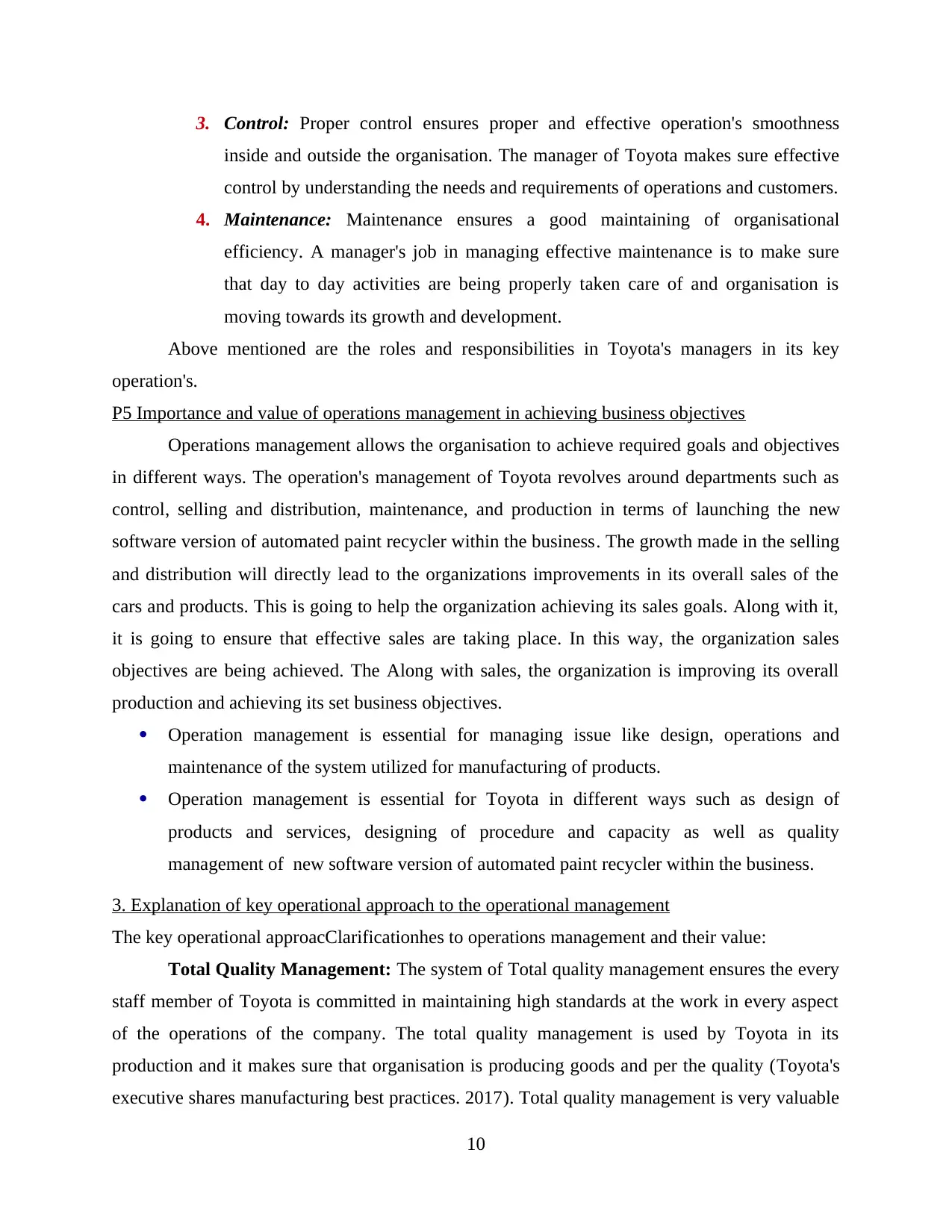
3. Control: Proper control ensures proper and effective operation's smoothness
inside and outside the organisation. The manager of Toyota makes sure effective
control by understanding the needs and requirements of operations and customers.
4. Maintenance: Maintenance ensures a good maintaining of organisational
efficiency. A manager's job in managing effective maintenance is to make sure
that day to day activities are being properly taken care of and organisation is
moving towards its growth and development.
Above mentioned are the roles and responsibilities in Toyota's managers in its key
operation's.
P5 Importance and value of operations management in achieving business objectives
Operations management allows the organisation to achieve required goals and objectives
in different ways. The operation's management of Toyota revolves around departments such as
control, selling and distribution, maintenance, and production in terms of launching the new
software version of automated paint recycler within the business. The growth made in the selling
and distribution will directly lead to the organizations improvements in its overall sales of the
cars and products. This is going to help the organization achieving its sales goals. Along with it,
it is going to ensure that effective sales are taking place. In this way, the organization sales
objectives are being achieved. The Along with sales, the organization is improving its overall
production and achieving its set business objectives.
Operation management is essential for managing issue like design, operations and
maintenance of the system utilized for manufacturing of products.
Operation management is essential for Toyota in different ways such as design of
products and services, designing of procedure and capacity as well as quality
management of new software version of automated paint recycler within the business.
3. Explanation of key operational approach to the operational management
The key operational approacClarificationhes to operations management and their value:
Total Quality Management: The system of Total quality management ensures the every
staff member of Toyota is committed in maintaining high standards at the work in every aspect
of the operations of the company. The total quality management is used by Toyota in its
production and it makes sure that organisation is producing goods and per the quality (Toyota's
executive shares manufacturing best practices. 2017). Total quality management is very valuable
10
inside and outside the organisation. The manager of Toyota makes sure effective
control by understanding the needs and requirements of operations and customers.
4. Maintenance: Maintenance ensures a good maintaining of organisational
efficiency. A manager's job in managing effective maintenance is to make sure
that day to day activities are being properly taken care of and organisation is
moving towards its growth and development.
Above mentioned are the roles and responsibilities in Toyota's managers in its key
operation's.
P5 Importance and value of operations management in achieving business objectives
Operations management allows the organisation to achieve required goals and objectives
in different ways. The operation's management of Toyota revolves around departments such as
control, selling and distribution, maintenance, and production in terms of launching the new
software version of automated paint recycler within the business. The growth made in the selling
and distribution will directly lead to the organizations improvements in its overall sales of the
cars and products. This is going to help the organization achieving its sales goals. Along with it,
it is going to ensure that effective sales are taking place. In this way, the organization sales
objectives are being achieved. The Along with sales, the organization is improving its overall
production and achieving its set business objectives.
Operation management is essential for managing issue like design, operations and
maintenance of the system utilized for manufacturing of products.
Operation management is essential for Toyota in different ways such as design of
products and services, designing of procedure and capacity as well as quality
management of new software version of automated paint recycler within the business.
3. Explanation of key operational approach to the operational management
The key operational approacClarificationhes to operations management and their value:
Total Quality Management: The system of Total quality management ensures the every
staff member of Toyota is committed in maintaining high standards at the work in every aspect
of the operations of the company. The total quality management is used by Toyota in its
production and it makes sure that organisation is producing goods and per the quality (Toyota's
executive shares manufacturing best practices. 2017). Total quality management is very valuable
10
⊘ This is a preview!⊘
Do you want full access?
Subscribe today to unlock all pages.

Trusted by 1+ million students worldwide
1 out of 16
Related Documents
Your All-in-One AI-Powered Toolkit for Academic Success.
+13062052269
info@desklib.com
Available 24*7 on WhatsApp / Email
![[object Object]](/_next/static/media/star-bottom.7253800d.svg)
Unlock your academic potential
Copyright © 2020–2025 A2Z Services. All Rights Reserved. Developed and managed by ZUCOL.





